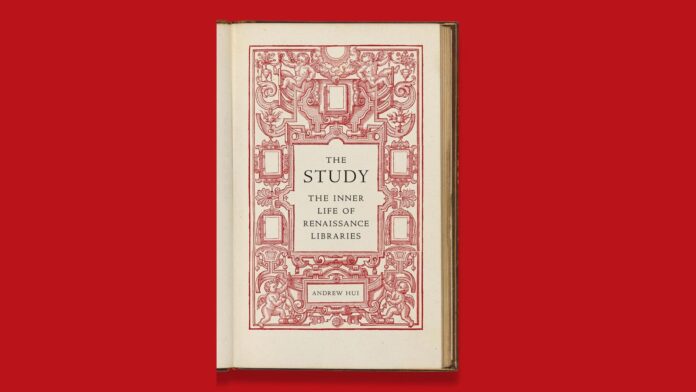The Study, is both an eminently solid explanation of the history of how spaces developed around books in the Renaissance and a more theoretical exploration of the impact of books and their associated spaces on cultures. Neatly split into two sections, ‘Bibliophilia’ and ‘Bibliomania’, it moves from the positive to the negative, mirroring the inevitable end of an untempered love of books. Hui’s prose is elegant and deliberately styled, melding personal discourse with a considered aesthetic.
As a book, it is a suitably handsome object. With heft and a rich red edged dustjacket, it is easy to see the value placed in the physical objects of books, yet the front cover does somewhat play with that idea, for what looks to an initial glance a Renaissance-styled front cover, is revealed on closer inspection to be a view of an open book, focusing on an ornate frontispiece, set on a red background. The book as a visual motif is further explored, with an in-depth consideration of Renaissance art, supported by plentiful illustrations.
The majority of texts drawn on in The Study were not written in English, with the majority in Latin. When discussing details, relevant sections are included in translation, but importantly Hui also includes the original text for any part he then goes on to examine more closely. For someone not interested or familiar with those languages this does not hinder understanding, but for those who are, it adds an extra element telescoping the distance between reader and original text.
Hui does assume considerable prior knowledge from the reader, using detailed technical terminology and referring to writers and critics with minimal explanation of who they are. Detailed notes are provided that point the reader to the relevant texts to consult further. It is also, I think, rather apt for a book called The Study, to require study, both in the sense of the verb and noun, to fully enjoy it. I found myself looking things up, reaching for things in my own study and having to refresh half-forgotten knowledge.
One element that elevates an erudite overview of the history of the study into a something particularly novel, is the comparisons between Renaissance Europe and other cultures, particularly Chinese and Islamic. The sense of concurrent evolution is remarkable. People, or at least those with sufficient privilege, are drawn to that blend of solitude and controlled sociability no matter their surrounding culture.
Of course, these cultures are not truly independent. Writing may have been invented independently, but by the time studies were developing it would be wrong to think of any culture as isolated from others. Cultures influence each other, even when knowledge transmission is not direct. An example of this can be see when looking at the transmission of technical skills, from geometric wooden inlays to paper itself.
The importance of the physical is made clear with Hui pointing out that when Montaigne, the famous French philosopher, visited the Vatican he was taken with a book from China and an Egyptian papyrus, both of which he couldn’t read. The physicality of those objects, which would have been very strange to Montaigne, is focused on and is more important than the information the text might transmit, if they could be understood. Hui goes as far as to say they are treated “almost like relics to behold and revere”. This physical reverence apart from literal meaning, which is explored in relation to collections of exotic objects (wunderkammer), is still just as relevant today and can be seen in the prominence of books as aesthetic props.
Studies are personal rooms which, along with their primary function, express the personality of the owner. The Study is similar, in that it has a deeply personal feeling, letting the reader get a sense of Hui’s character. Authorial personality in non-fiction is a common method to keep readers engaged and also gives a nexus around which to structure a book, excusing tangents and specific focuses. Yet, this does more, for it openly addresses the personal nature of Hui’s viewpoint and analysis. He notes that “our lived experience as readers cannot be separated from our profession as scholars”. Scholars are not the only ones who should consider how their experience shapes their reading, for all texts shape and are shaped by those who produce and read them.
Words by Ed Bedford
Want more Books content from The Indiependent? Click here
